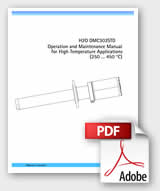Energy Optimization via Humidity Control
Industrial dryers and ovens are major sources of energy consumption in various business segments. Pulp and paper, petrochemical, chemical, insulation, wallboard, pet food, corn wet milling, food, cement and lime are just some of these business segments. One of the most important variables in drying is to control exhaust humidity to a certain humidity content. If the humidity content is too high, evaporation rates can be affected and condensation on backend equipment can occur. If the humidity content is too low, then the process is heating up too much air causing a waste of energy. Below are a few examples of different drying processes where humidity control benefits are explained.
Spray Dryers
Spray dryers atomize a slurry in a drying chamber where moisture is evaporated and a powder is the final product. Most spray dryers are controlled using the exhaust gas temperature as a setpoint to a correlated product moisture. The dryer is then controlled by manipulating either the inlet temperature of the dryer or the feed rate to keep the desired setpoint.
Issues that can occur with this type of control, especially in lower inlet temperature spray dryer applications, is that ambient humidity changes affect the evaporation rate of the dryer. Outlet temperature cannot detect the ambient humidity changes, so operators need to over dry to compensate so the product moisture stays within specification. Using an exhaust humidity sensor detects the ambient humidity changes, so the dryer can be optimized at all times and over drying doesn’t occur.
Basic Payback for Baby Formula Spray Dryer:
Dryer Capacity: 1000 kg/hr
Dryer yearly operation: 7000 hrs
Feed % solids: 50%
Moisture Spec: 5% moisture
Baby formula cost to mfr (including energy): $17.6/kg
Cost of over drying 1%: $1,232,000 per year
The manufacturer would realize an increased profit of $1,232,000 / year if they incorporated exhaust humidity control and tighten product moisture control.
Another benefit of exhaust gas humidity control is that dryer operators also have issue with buildup within the dryer that has to be cleaned. In order to clean the dryer, it has to come down for maintenance. Relative humidity is the main variable of when buildup will occur in the dryer. Controlling to a maximum relative humidity in the exhaust gas will maximize the capacity on the dryer while protecting against build up. This type of control optimizes the capacity of the dryer at a given energy usage rate.
An average energy usage rate for a spray dryer is 4.87 GJ per metric ton of water evaporated. At a natural gas rate of $4(US)/GJ for the dryer listed above, the energy cost is $21.64/hr or $151,511.11 per year. The energy saving cost portion of the example above is $30,200 at 20% energy savings. In Europe, the energy savings could be twice that with their current energy prices.
Basic Gas Side Energy Balance – Generic Dryer
In order to optimize a dryer, the minimum energy required to evaporate the dryer water load must be calculated. If we use the dryer variables above, there were 950 kgs of dry product entering the dryer and 950 kgs of water entering dryer. In the product leaving the dryer, there were 950 kgs of dry product and 50 kgs of water. Therefore, the dryer must provide enough energy to evaporate 900 kgs of water an hour. If we calculate the energy of the inlet air and outlet air, we then can determine if the exhaust humidity is too low and energy is being wasted.
Energy Balance Example
Inlet air temp before heating: 25 C
Inlet air humidity ratio (grams of water/grams of dry air): 7 g/kg
Enthalpy of gas: 43.35 kJ/kg
Inlet air after heating: 250 C
Enthalpy of gas after heating: 272.3 kJ/kg
Air mass flow rate: 18000 kg/hr
Energy required to heat up inlet air: 4.12 GJ/hr
Energy required to evaporate 900 kgs/ hr of water (2.3 GJ/metric tonne of H2O): 2.07 GJ/hr
Exhaust gas humidity ratio: 57 g/kg
Energy Reduction
Reduced mass flow rate: 15000 kg/hr
Energy required to heat up inlet air: 3.4 GJ/hr
Exhaust gas humidity ratio: 67 g/kg
Energy Savings: $20,160 per year
As you can see in the example, air/mass flow and humidity are inversely related. The actual required energy to evaporate the water is 2.07GJ/hr so there is still some room to improve. There are energy losses due to ambient conditions but a lot of energy is wasted in the exhaust gas. The more a dryer is fine tuned with variable speed fans and humidity sensors, the more efficient and accurate they become in providing a consistent end product moisture.
See attached spreadsheet (Convective Dryer Enthalpy) to calculate your gas side dryer efficiency. Also see document on Energy / Humidity Ratio Energy calculations.
Convective Dryer Enthalpy



